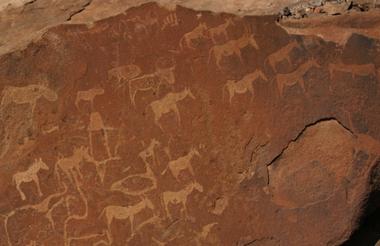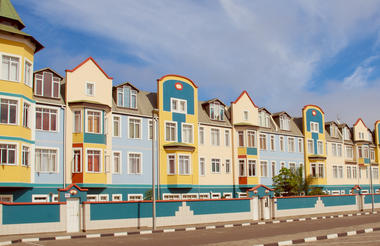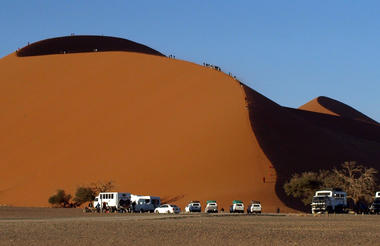


- Travel time: about 40'
- Suggestions for restaurants in Windhoek will be provided
- Private airport transfer
- Dinner and breakfast
- Extra transfers
- Other meals and drinks
- Laundry
- All extra services and/or activities stated as Optional or Recommended
- Wifi might be at an additional cost
- Tips


- Travel time: about 3h
- Morning departure is advisable
- Special dietary requirements can be accommodated
THE AfriCat FOUNDATION CARNIVORE CARE & INFORMATION CENTRE (ACCC)
- Private vehicle and driver
- All meals
- House drinks
- AfriCat Foundation visit
- Planned Lodge-activities and safaris
- Park and reserve permits and fees
- Extra transfers
- Menu "a la carte"
- Premium drinks
- Laundry
- All extra services and/or activities stated as Optional or Recommended
- Wifi might be at an additional cost
- Tips
Etosha National Park
Regarded by safari enthusiasts as one of Africa's greatest wildlife sanctuaries, Etosha National Park - dominated by its enormous shimmering salt pan - is an area of wild savannah, umbrella thorn acacias, and mopane woodland and is home to a fantastic array of animals. The park measures 22,935 sq km, while all the pans cover more than 4,730 sq km. Despite its arid appearance, the park is packed with familiar faces and protects over 100 species of mammal, 16 species of reptile, and 340 species of bird. The name "Etosha" means "great white place of dry water" and comes from the Etosha Pan, a vast, flat, saline desert. When a good rainy season occurs, the normally dry river channels carry water to this gentle depression turning it into a shallow lagoon. This unusual oasis then becomes a busy watering hole as it draws in a variety of animals and, for a few days each year, thousands of flamingos and pelicans. You are likely to see elephants, giraffe, lion, leopard, Burchell's zebra, and the desert specialists like springbok and the handsome gemsbok. It's also one of the best places in southern Africa to spot the endangered cheetah and black rhino, not to mention rare antelope species like black-faced impala, Damara dik-dik, and roan antelope. The birds include an exciting blend of savannah, wetland, and semi-desert birds such as korhaan, marabou, yellow-billed hornbill, ostrich, white-backed vulture, and the enormous kori bustard, which can exceed 15kg in weight. Visitors are free to explore the pans in their own vehicles, and detailed maps and game guides are offered on entry.



- Travel time: about 4h
- Morning departure is advisable
- Special dietary requirements can be accommodated
- Private vehicle and driver
- All meals - 1 lunch in Halali Camp (Etosha National Park)
- House drinks
- 1 full-day safari in Etosha National Park
- Planned Lodge-activities and safaris
- Park and reserve permits and fees
- Extra transfers
- Menu "a la carte"
- Premium drinks
- Laundry
- All extra services and/or activities stated as Optional or Recommended
- Wifi might be at an additional cost
- Tips



- Travel time: about 4h
- Morning departure is advisable
- Special dietary requirements can be accommodated
- Private vehicle and driver
- All meals
- House drinks
- Planned Lodge-activities and safaris
- Park and reserve permits and fees
- Extra transfers
- Menu "a la carte"
- Premium drinks
- Laundry
- All extra services and/or activities stated as Optional or Recommended
- Wifi might be at an additional cost
- Tips
Damaraland
The name of this region comes from the Damara people who live here and constitute a large share of its very low population. The region is also home
to a variety of game including zebra, giraffe, antelope, elephant and black rhino. Damaraland is famous for its numerous, intriguing natural landmarks such as the Petrified Forest, the volcanic Burnt Mountain, and the basalt Organ Pipes, a peculiar geological feature comprising numerous 12-foot high dolerite columns. Damaraland incorporates the Brandberg, Twyfelfontein, and Spitzkoppe and is also renowned for its incredible prehistoric rock paintings and engravings. Brandberg means ‘fire mountain’ and it is so called because of the effect of the setting sun on its western face. At 8,550 feet, its summit is Namibia’s highest peak. Here you will find the Tsisab and Numas ravines, both displaying a multitude of weird and wonderful rock paintings.
Twyfelfontein
The site of Twyfelfontein site is included in the UNESCO World Heritage List. It forms a coherent, extensive and high-quality record of ritual practices relating to hunter-gatherer communities in this part of southern Africa over at least 2,000 years, and eloquently illustrates the links between the ritual and economic practices of hunter-gatherers.Twyfelfontein boasts one of the most extensive collections of rock art in Africa with over 2,500 examples scattered around the local area. The engravings are about 6,000 years old and were most likely made by San hunters during the Early Stone Age. The images (which are dominated by animals and animal tracks) were created by cutting into the soft stratum that coats the local sandstone. When the rocks subsequently eroded, this stratum was regenerated, hence covering the original engravings and preserving them for thousands of years. Not far from Twyfelfontein is a distinctive, volcanic ridge and the unusual Burnt Mountain, which looks exactly as its name suggests; as if someone has set fire to a mountain and all that is left is a pile of ashes and clinker.



- Travel time: about 4h30'
- Morning departure is advisable
- Special dietary requirements can be accommodated
- Private vehicle and driver
- All meals
- House drinks
- Twyfelfontein guided tour
- Damara Living Museum experience
- Desert Elephant tracking and safari
- Planned Lodge-activities and safaris
- Park and reserve permits and fees
- Extra transfers
- Menu "a la carte"
- Premium drinks
- Laundry
- All extra services and/or activities stated as Optional or Recommended
- Wifi might be at an additional cost
- Tips
Cape Cross Seal Reserve
Cape Cross has both historical and biological significance and is a popular tourist attraction. The Portuguese navigator, Diego Cão, landed here in 1486 on his second expedition south of the equator and planted a stone cross (padrão) to mark his journey. A replica is visible here today. Inclusive of a second replica, the area has been listed as a National Heritage Site. In the late 1800s, thousands of tons of guano (dried excrement of fish-eating birds used as fertilizer) were collected and exported to Europe. Cape fur seals were also harvested. About 100 workers lived at Cape Cross, and a police station, customs, and post office were established at the settlement, while a railway (the first in the country) was built to cross the salt pan and transport workers. Many men lost their lives due to the harsh conditions at Cape Cross. This reserve is a sanctuary for the world’s largest Cape fur seals breeding colony, with up to 210,000 seals present during the breeding season in November and December. Sustainable seal harvesting occurs in reserve annually under the Ministry of Fisheries and Marine Resources auspices, which also sets the quota of seals to be harvested.
The Zeila Shipwreck
The Zeila Shipwreck is an offshore fishing vessel that ran aground in 2008. Namibia’s infamous ‘Skeleton Coast’, also nicknamed the "The Land God Made in Anger", and "The Gates of Hell" is a desolate stretch of desert running right to the sea, where the cold Benguela current create strong currents, rough seas, and dense fogs. The latter in particular have been responsible for the thousand or so shipwrecks along the coast. A great photo-op, especially with the roosting birds that have taken up residence on it, the Zeila is a reminder of the power of nature at the ‘End of the Earth’ where lions hunt seals and elephants wade through the surf.
Swakopmund
It looks like being in Germany! Swakopmund, known as Swakop in Namibia, is the country’s biggest coastal town and a resort for Namibians on holiday. The city’s German origins are quite pronounced in beautiful old German colonial buildings throughout the city, making an even starker contrast for this town sitting at the edge of the Namib Desert. Why would we like our clients to stay in Swakopmund? Beautiful dunes, a vibrant city, and above all, Sandwich Harbour. Once you obtain the permit (instructions will be given), you drive along a beautiful dune chain adjacent to the Atlantic Ocean, zigzagging the original railway line between Swakopmund and Walvis Bay. This is an opportunity for a detailed look at the formation of ‘the world’s oldest desert’ and the bird paradise surrounding you. The dramatic landscape will capture your imagination as soon as you get close to the dunes and the ocean. It will quickly become clear why Sandwich Harbour is often described as inaccessible! Spring tides and shifting sands ensure an unpredictable route, but as you approach the towering, wind-sculptured dunes at the edge of Sandwich Harbour, there is a sense of entering a different world. You will drive on a thin stretch of sand between the dunes and the ocean. A truly unique experience.
Activities at Swakopmund
Boat Trips: We highly recommend taking a boat cruise whilst in Swakopmund. You can enjoy trips up the coast to Pelican Point, the Oyster.
Farm, Bird Island, and the Lighthouse. At the right time of year (July-November) you can expect to see Bottlenose & Heaviside Dolphins, Cape Fur Seals, Penguins, Whales & Leatherback Turtles.
Quad Biking: Head out into the dunes behind Swakopmund on quad bikes that reach areas you won’t be able to get to any other way. You can choose trips that will take you out from one hour to a full morning - a fun trip for all the family.
Scenic Flights: Take a low-level flight up the Skeleton Coast to see the best views of the many shipwrecks that have made this coastline so well known. The planes are five - nine seaters and you can book seats for trips down to Sossusvlei (2 h) or up to the Skeleton Coast (2 h) and it's worth being aware that fuel prices fluctuate hugely and these trips are best booked in advance. Prices vary from 390 USD pp - 985 USD pp depending on numbers in the plane.
Kayak Trips: From Walvis Bay, you can take guided kayak trips around Pelican Point which is ideal for birders. Trips are for two hours or a full morning and are done at this time of the day due to the winds.
Sandwich Harbour
It is an area on the Atlantic coast of Namibia that includes a bay in the north and a lagoon at the southern end. Formerly the bay was a moderately-sized commercial port based around whaling and small-scale fishing, but it is now best known for its birdlife in the lagoon to the south of the bay.
Sandwich Harbour, part of the Namib Naukluft Park, is a place many have heard of but very few have ever visited. The lagoon, salt pans, and the bird sanctuary, which form the Walvis Bay Wetlands, are rightly heralded as the single most important coastal wetlands of Southern Africa. It is one of five Ramsar sites in Namibia. Giant sand dunes run straight into the ocean, creating breathtaking sceneries and unique landscapes, just waiting to be discovered!


- Travel time: about 4h
- Morning departure is advisable
- Special dietary requirements can be accommodated
- Private vehicle and driver
- All meals
- House drinks
- Sandwich Harbour Dune&Ocean 4x4 tour
- Park and reserve permits and fees
Sossusvlei and Dead Vlei
One of the most extraordinary sights in Namibia, if not the world. The eternally shifting red dunes tower 300 m over the Namib desert (the
the oldest desert in the world) and its ancient clay pans. The dunes in the Namib Naukluft Park formed on the coast and gradually shifted inland for millions of years. This endless wind pushing sand ever forward creates the fantastic shapes for which Sossusvlei has become so famous. The pans rarely get water, but on the rare occasion, the Namib does see rain, the pans spring into life. Trees once grew here, but these have long since died, their dried and blackened skeletons still standing 900 years later. To experience the true beauty of these vast structures, they should be climbed at sunrise or sunset when the colors and shapes transform before your eyes. The gates to the dunes open an hour before sunrise. There is then a 60km drive along tar road through the park before you reach the famous pans. Along this road, you will see a sign for Dune 45, this is an excellent place to watch the sunrise over the dunes. It is also a slightly easier dune to climb. If you prefer to avoid the crowds, keep driving to Dead Vlei. The last 5km is through deep sand and is for 4x4 vehicles; the signs for Dead Vlei and experience the extraordinary beauty of this pan before anyone else arrives.





- Travel time: about 5h
- Morning departure is advisable
- Special dietary requirements can be accommodated
- Private vehicle and driver
- All meals
- House drinks
- Dune 45, Sossusvlei, and Deadvlei sand 4x4 and hike guided tour
- Planned Lodge-activities and safaris
- Park and reserve permits and fees
- Extra transfers
- Menu "a la carte"
- Premium drinks
- Laundry
- Hot air balloon flight
- All extra services and/or activities stated as Optional or Recommended
- Wifi might be at an additional cost
- Tips



- Travel time: about 4h 30'
- Morning departure is advisable
- Special dietary requirements can be accommodated
- Private vehicle and driver
- All meals
- House drinks
- Planned Lodge-activities and safaris
- Park and reserve permits and fees
- Extra transfers
- Menu "a la carte"
- Premium drinks
- Laundry
- All extra services and/or activities stated as Optional or Recommended
- Wifi might be at an additional cost
- Tips
- Travel time: about 1h 30'
- Private airport transfer






